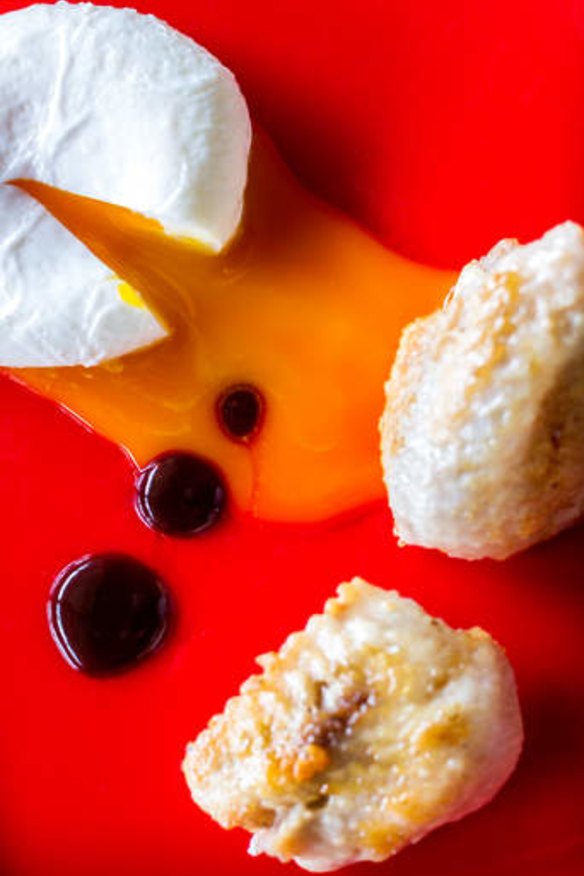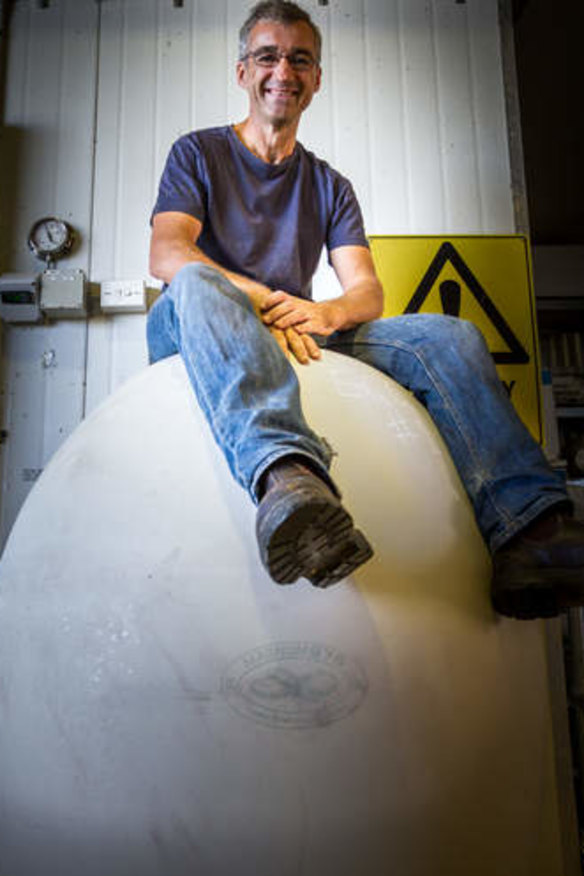Oenology experiment goes egg-shaped

Eggs are definitely on my mind lately. Something about the perfection of the reproductive unit's shape. From there I'm off thinking about the concept of the cosmic egg, and then the fact I just came into possession of a 700-kilogram version myself.
This egg, which stands more than 1.5 metres high and, to clarify, resembles a chicken's egg rather than the more amorphous form of a frog's or shark's egg, is beautiful, porcelain white - well, it invades all your thoughts. So I'm pondering life's ultimate questions on a moonlit night, such as the old ''Which came first, the chicken or the egg?'', ''Is there anybody out there?'' and, vaguely, ''Where's a metaphysicist when you need one?''.
I know, you are probably wanting more explanation about this huge egg. Have I unearthed a remnant of Australia's prehistoric megafauna? Or am I practising a weird eurythmic rebirthing ceremony at night? To put your mind at rest, I haven't, in an amazing feat of amateur palaeontologic endeavour, stumbled on evidence that twenty-foot-high chickens used to roam Ngunnawal country. What I've done is purchase a huge ceramic egg in which to make wine.

I should explain the theory here. We've come a long way in oenological terms since the first wines were made some six millennia ago. There's no end to technology you can invest in. Against this is a growing trend to return to a less technology-driven process - just let the grapes do their thing, use more natural materials, be passive rather than interventionist. I'm not quite ready to rip the shirt off and make wine on the waxing moon, but I am questioning the increasing reliance on formulations, additives and technology that large corporates are thrusting our way. So I'm looking at alternatives.
Amphorae were the original wine vessels; they are always unearthing them in ancient lands. They are still being used in various countries to make wine. The shape here is a true egg, made of finer material such as ceramic. The ''egg'' is a vessel that is meant to have certain energies that allow the wine to be made and matured. The shell is about 12 millimetres thick, looks like porcelain and has a quite large thermal mass, so wine inside is subjected to slow cooling and warming currents. The ovoid shape, which is technically an infinite arch, allows these thermals to very gently keep the wine in perpetual motion. Well, it's all this or I'm consuming way to much spirulina and anthroposophy.
The best way to see if this is the case is to trial some winemaking in this against our usual modern methods. The egg in question came to me quite generously for experimentation via a company that sells everything to do with winemaking both ancient and modern. If there's an advantage, great, I'll invest in more, as they look amazing - exactly as you'd imagine a 700- litre egg would look. They are made in Byron Bay by a company that also designs biodynamic watering systems, so there's that inbuilt spirituality about it anyway. If it doesn't work, well, I'll have the best water feature in the street.
Whether you are a theologian or a scientist, you have to agree that there is something special about the simplicity of a perfectly cooked egg. Poaching an egg is fraught with difficulties unless you have the ability to hang out while the chicken lays it and then rush back to cook it. A freshly laid egg is almost impossible to mess up. When lowered into the simmering water the white will envelope the yolk, and a couple of minutes later it will be ready, a porcelain-white pillow of perfection.
If you don't have this ability, then you might need to take on Harold McGee's technique. McGee wrote the bible on the science of cooking years ago, and in his somewhat simplified second book, Keys to Good Cooking, he explains how to get the most out of your egg. The white tends to break down first, and when placed in water it falls apart readily. If you strain off as much of this thin white as possible you are well set to have a nice neat orb. Also, the water shouldn't ever boil. Poaching is the key word - that's 82C-85C on the thermometer.
The chicken and the egg
4 fresh farm eggs
12 large chicken wings
100g salt
1 cup goose fat or olive oil
2 cloves garlic, peeled, flattened
¼ cup sake
2 tbsp soy
2 tbsp mirin
Extra salt to cook the eggs
First, deal with the chicken, though don't judge me for choosing this first. Cut out the middle section of each wing at the joints. Set aside the other two sections, the tips and drumstick ends. The middle section has two bones in it. Carefully make a cut at each end of the meat, between the bones. This will make it easier to remove the bones after cooking.
Dissolve the 100 grams of salt in a litre of water. Add the prepared chicken wing sections and brine for an hour. Drain and pat dry. Heat the oven to 80C. Place the goose fat or olive oil in a pot, bring it to a simmer on the stove. Put the drained chicken wing parts in a pot or dish small enough so that they fit snugly. Pour the hot oil or goose fat over the chicken wings until it totally covers the chicken. Bake in the oven for at least an hour. Remove and cool in the fat until you can handle them. Now cut down the back of the wing and very carefully remove the two bones. Chill.
For the sauce, chop up all the wing tips (keep the little drumstick sections for another use). Fry the chopped tips in a little fat until well browned, add ¼ cup water and the mirin, soy and sake. Cook down to a very thick sauce. Strain and reserve. You will need only about four tablespoons.
Cook the eggs. Bring a pot of salted water to a very low simmer (82C). Break the eggs into a strainer to drain off any thin egg white. Stir the simmering water to create a gentle vortex and slip each egg in. Cook for four to five minutes. Scoop out.
Fry the confit chicken wings until crisp and serve with poached eggs and a dollop of the soy reduction.
>> Bryan Martin is winemaker at Ravensworth and Clonakilla.
The best recipes from Australia's leading chefs straight to your inbox.
Sign up